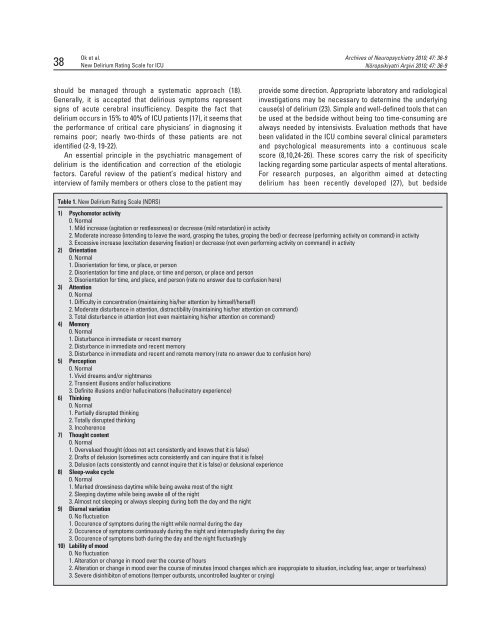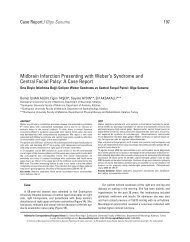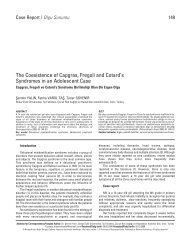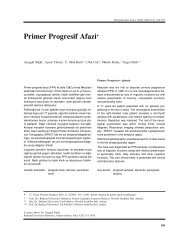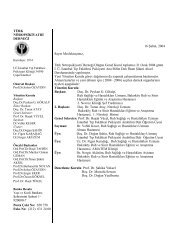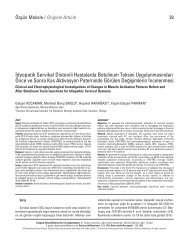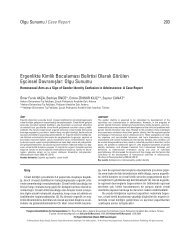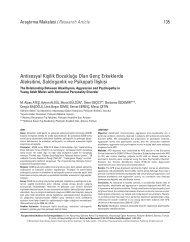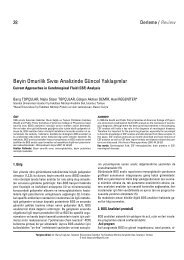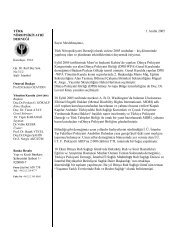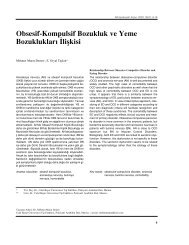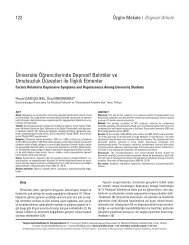New Delirium Rating Scale for ICU - Nöropsikiyatri ArÅivi Dergisi
New Delirium Rating Scale for ICU - Nöropsikiyatri ArÅivi Dergisi
New Delirium Rating Scale for ICU - Nöropsikiyatri ArÅivi Dergisi
Create successful ePaper yourself
Turn your PDF publications into a flip-book with our unique Google optimized e-Paper software.
38<br />
Ok et al.<br />
<strong>New</strong> <strong>Delirium</strong> <strong>Rating</strong> <strong>Scale</strong> <strong>for</strong> <strong>ICU</strong><br />
Archives of Neuropsychiatry 2010; 47: 36-9<br />
Nöropsikiyatri Arflivi 2010; 47: 36-9<br />
should be managed through a systematic approach (18).<br />
Generally, it is accepted that delirious symptoms represent<br />
signs of acute cerebral insufficiency. Despite the fact that<br />
delirium occurs in 15% to 40% of <strong>ICU</strong> patients (17), it seems that<br />
the per<strong>for</strong>mance of critical care physicians’ in diagnosing it<br />
remains poor; nearly two-thirds of these patients are not<br />
identified (2-9, 19-22).<br />
An essential principle in the psychiatric management of<br />
delirium is the identification and correction of the etiologic<br />
factors. Careful review of the patient’s medical history and<br />
interview of family members or others close to the patient may<br />
provide some direction. Appropriate laboratory and radiological<br />
investigations may be necessary to determine the underlying<br />
cause(s) of delirium (23). Simple and well-defined tools that can<br />
be used at the bedside without being too time-consuming are<br />
always needed by intensivists. Evaluation methods that have<br />
been validated in the <strong>ICU</strong> combine several clinical parameters<br />
and psychological measurements into a continuous scale<br />
score (8,10,24-26). These scores carry the risk of specificity<br />
lacking regarding some particular aspects of mental alterations.<br />
For research purposes, an algorithm aimed at detecting<br />
delirium has been recently developed (27), but bedside<br />
Table 1. <strong>New</strong> <strong>Delirium</strong> <strong>Rating</strong> <strong>Scale</strong> (NDRS)<br />
1) Psychomotor activity<br />
0. Normal<br />
1. Mild increase (agitation or restlessness) or decrease (mild retardation) in activity<br />
2. Moderate increase (intending to leave the ward, grasping the tubes, groping the bed) or decrease (per<strong>for</strong>ming activity on command) in activity<br />
3. Excessive increase (excitation deserving fixation) or decrease (not even per<strong>for</strong>ming activity on command) in activity<br />
2) Orientation<br />
0. Normal<br />
1. Disorientation <strong>for</strong> time, or place, or person<br />
2. Disorientation <strong>for</strong> time and place, or time and person, or place and person<br />
3. Disorientation <strong>for</strong> time, and place, and person (rate no answer due to confusion here)<br />
3) Attention<br />
0. Normal<br />
1. Difficulty in concentration (maintaining his/her attention by himself/herself)<br />
2. Moderate disturbance in attention, distractibility (maintaining his/her attention on command)<br />
3. Total disturbance in attention (not even maintaining his/her attention on command)<br />
4) Memory<br />
0. Normal<br />
1. Disturbance in immediate or recent memory<br />
2. Disturbance in immediate and recent memory<br />
3. Disturbance in immediate and recent and remote memory (rate no answer due to confusion here)<br />
5) Perception<br />
0. Normal<br />
1. Vivid dreams and/or nightmares<br />
2. Transient illusions and/or hallucinations<br />
3. Definite illusions and/or hallucinations (hallucinatory experience)<br />
6) Thinking<br />
0. Normal<br />
1. Partially disrupted thinking<br />
2. Totally disrupted thinking<br />
3. Incoherence<br />
7) Thought content<br />
0. Normal<br />
1. Overvalued thought (does not act consistently and knows that it is false)<br />
2. Drafts of delusion (sometimes acts consistently and can inquire that it is false)<br />
3. Delusion (acts consistently and cannot inquire that it is false) or delusional experience<br />
8) Sleep-wake cycle<br />
0. Normal<br />
1. Marked drowsiness daytime while being awake most of the night<br />
2. Sleeping daytime while being awake all of the night<br />
3. Almost not sleeping or always sleeping during both the day and the night<br />
9) Diurnal variation<br />
0. No fluctuation<br />
1. Occurence of symptoms during the night while normal during the day<br />
2. Occurence of symptoms continuously during the night and interruptedly during the day<br />
3. Occurence of symptoms both during the day and the night fluctuatingly<br />
10) Lability of mood<br />
0. No fluctuation<br />
1. Alteration or change in mood over the course of hours<br />
2. Alteration or change in mood over the course of minutes (mood changes which are inappropiate to situation, including fear, anger or tearfulness)<br />
3. Severe disinhibiton of emotions (temper outbursts, uncontrolled laughter or crying)


